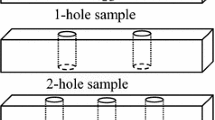Abstract
In this paper, a new contribution regarding the application of principal component analysis (PCA) technique is used to detect defects in wood. For this purpose, a PCA procedure is modeled and developed accordingly. The results show that this method is applicable, appropriate and reliable for identifying defects in wood and is able to separate the clear wood from the others. In particular, in the case of wood with holes, all the squared prediction errors (SPE) were higher than their threshold while in clear wood all SPE values were less than their threshold and their values are far enough from the threshold line.





Similar content being viewed by others
References
Chen Y, Lan L (2009) A fault detection technique for air-source heat pump water chiller/heaters. Energy Build 41:881–887
Collacott RA (1977) Mechanical Fault Diagnosis. Chapman and Hall, New York
Iserman R (2006) Fault-diagnosis systems: an introduction from fault detection to fault tolerance. Springer-Verlag, Berlin
Jackson JE, Edward A (1991) A user’s guide to principal components. Wiley, New York
Jolliffe IT (1986) Principal component analysis. Springer-Verlag, New York
Kilic E (2005) Fault detection and diagnosis in nonlinear dynamical system. Dissertation, Middle East Technical University
Packianather M S, Drake P R (2005) Identifying defects on plywood using a minimum distance classifier and a neural network. IPROMS 543–548
Pham D T, Alcock R J (1996) Automatic detection of defects on birch wood boards. Proceedings of the institution of mechanical engineers, Part E, journal of process mechanical engineering. 210: 45–52
Pham DT, Soroka AJ, Ghanbarzadeh A, Koc E, Otri S, Packianather M (2006) Optimising neural networks for identification of wood defects using the bees algorithm. In: Industrial informatics, IEEE international conference on INDIN 06, p 1346–1351
Simani S, Fantuzzi C, Patton RJ (2002) Model-based fault diagnosis in dynamic system using identification techniques. Springer-Verlag, London
Tharrault Y, Mourot G, Ragot J, Maquin D (2008) Fault detection and isolation with robust principal component analysis. Int J Appl Math Comput Sci 18:429–442
Wang S, Cui J (2005) Sensor-fault detection, diagnosis and estimation for centrifugal chiller systems using principal-component analysis method. Appl Energy 82:197–213
Wang S, Cui J (2006) A robust fault detection and diagnosis strategy for centrifugal chillers. HVAC&R Res 12:407–428
Xiao F (2004) Sensor fault detection and diagnosis of air handling units. Dissertation, Hong Kong Polytechnic University
Author information
Authors and Affiliations
Corresponding author
Rights and permissions
About this article
Cite this article
Tafarroj, M.M., Kalani, H., Moavenian, M. et al. An application of principal component analysis method in wood defects identification. J Indian Acad Wood Sci 11, 33–38 (2014). https://doi.org/10.1007/s13196-014-0114-2
Received:
Accepted:
Published:
Issue Date:
DOI: https://doi.org/10.1007/s13196-014-0114-2




